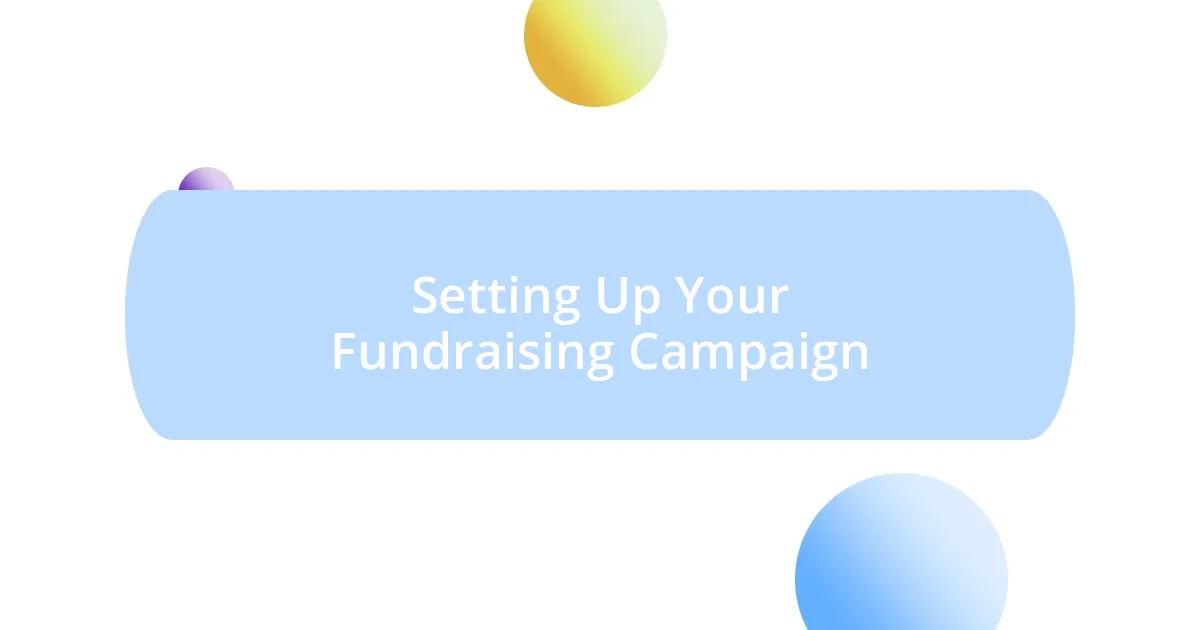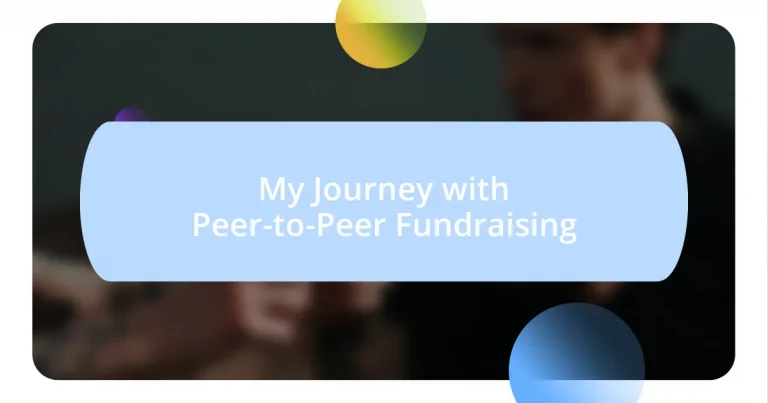Key takeaways:
- Peer-to-peer fundraising creates emotional connections by transforming donors into advocates through personal storytelling.
- Success is measured not just by funds raised, but by milestones achieved and the community’s engagement and feedback throughout the campaign.
- Authenticity and vulnerability enhance supporter engagement, fostering deeper connections and increasing motivation.
- Timing and persistence are crucial; aligning updates with significant events can lead to unexpected contributions, despite occasional dips in motivation.

Introduction to Peer-to-Peer Fundraising
Peer-to-peer fundraising is a dynamic way to engage supporters in raising money for a cause they believe in. I remember the first time I participated in a peer-to-peer campaign; it felt like joining a community on a mission. The excitement of watching friends rally together, sharing their personal stories, and motivating each other created an emotional bond that was truly inspiring.
The beauty of this fundraising model lies in its ability to leverage personal networks. Think about it: who knows your favorite cause better than your friends and family? They’re often more receptive to a heartfelt ask from someone they know rather than a generic donation request. When I shared my story about why I was fundraising for local youth programs, I was amazed at how quickly people rallied around my passion, each one adding their own unique connection.
In essence, peer-to-peer fundraising transforms donors into advocates, creating a ripple effect of generosity. Each person involved can amplify the message, providing a layer of authenticity that traditional fundraising might lack. Have you ever experienced the thrill of contributing to something bigger, where you felt both inspired and empowered? That’s the essence of peer-to-peer fundraising—it’s collective action fueled by personal commitment and connection.

Setting Up Your Fundraising Campaign
Setting up your fundraising campaign is like mapping out a journey. I still remember the exhilarating energy I felt when drafting my campaign goals. It’s essential to start with a clear vision—define what you hope to achieve and how the funds will be used. This clarity will guide your messaging and motivate your supporters.
Here are a few key steps to consider while setting up your campaign:
- Choose a compelling cause: Share personal stories or experiences that reinforce why this cause matters to you. Authenticity resonates.
- Set a realistic fundraising goal: Break it down into manageable milestones to maintain momentum as you progress.
- Create a vibrant campaign page: Use eye-catching visuals and engaging descriptions to draw in potential donors.
- Leverage social media: Regular updates and emotional calls-to-action can keep supporters engaged and inspire them to share your campaign.
- Align supporters with a personal touch: Encourage them to share their own stories that tie back to your cause, deepening their connection and commitment.
With every step, I found that weaving my personal experiences into the campaign truly connected with my audience. It transformed the process from just raising money to creating a community of supporters who believed in our shared mission.

Strategies for Engaging Your Network
Engaging your network in peer-to-peer fundraising is all about personal connection. I remember when I reached out to my friends via social media with a heartfelt video about why youth programs mattered to me. The response was incredible! Friends I’d not spoken to in years felt inspired to donate and share my message, proving how impactful a personal touch can be. It’s essential to create that emotional bridge where your supporters feel they are part of your journey.
In my experience, inviting supporters to share their own stories can deepen engagement significantly. I encouraged my friends to post about their own experiences with youth programs, creating a beautiful tapestry of shared memories. This not only expanded our reach but also made everyone feel valued. When individuals see that they can contribute their own voices, it transforms the fundraising effort into a collective movement rather than just a transaction.
Another strategy I found effective was hosting small gatherings, virtually or in-person, to discuss my fundraising goals. I recall organizing a casual coffee chat over Zoom, where we talked about the cause and brainstormed ways to spread the word. It felt like a team effort, and everyone left feeling energized and motivated to help out. These interactive sessions foster a sense of belonging and teamwork, which is vital for maintaining enthusiasm throughout the campaign.
| Strategy | Description |
|---|---|
| Personal Storytelling | Use your own experiences to connect with supporters on an emotional level. |
| Encourage Shared Experiences | Invite your network to share their stories related to your cause, creating a collective narrative. |
| Interactive Gatherings | Host informal meetings to discuss your goals and get input from your supporters. |

Measuring Success of Your Campaign
When it comes to measuring the success of your peer-to-peer fundraising campaign, I’ve found that it’s essential to look beyond just the dollar amount raised. For me, celebrating small victories along the way—like attaining certain milestones or receiving heartfelt messages from supporters—was just as important. Are those moments not what truly reflect the campaign’s impact on the community? Each story shared, each connection made, added a layer of value that numbers alone can’t capture.
I remember vividly the day we hit our first major milestone—$1,000. It wasn’t just a financial achievement; it ignited a wave of excitement among my supporters. They rallied around that accomplishment, sharing it on their social platforms and inviting others to join in. The enthusiasm was contagious! I realized then that momentum plays a crucial role in the success of a campaign. By regularly communicating updates and encouraging engagement, I grew a supportive network that felt invested in the journey.
To further gauge success, consider utilizing surveys or feedback forms post-campaign. I decided to reach out to my supporters after the campaign wrapped up and asked them what resonated with them the most. The insights I received were invaluable. Not only did I learn what worked well, but I also grasped areas for improvement. This reflective process was incredibly rewarding, and it helped me shape my approach for future campaigns. Wouldn’t you agree that understanding your supporters’ perspectives can lead to even greater impact down the line?

Lessons Learned from My Experience
One key lesson I learned from my experience is the importance of authenticity. There were moments when I felt the pressure to put on a facade, presenting my campaign in a way I thought others expected. But when I allowed myself to be vulnerable and share my struggles and triumphs, I noticed a remarkable shift in engagement. Isn’t it interesting how showing our true selves can foster deeper connections? My supporters responded more enthusiastically when they could see my genuine passion and commitment.
Another significant insight I gained is that timing matters greatly. I remember sending out updates during critical moments, like around holidays or community events, and witnessing a spike in donations. It was during a local festival that I shared an inspiring story about the impact of our work, and my network rallied together with unexpected contributions. Are there times within your own life that you think could align perfectly with your fundraising efforts? Those little coincidences can turn into major opportunities, making your message resonate even more.
Lastly, I learned that persistence pays off. There were days when motivation dipped, and I thought about giving up. Yet, I decided to send a quick update or thank my supporters, even when progress felt slow. I remember a day when I posted an update that felt redundant, but surprisingly, it led to several donations coming in that very afternoon. Can you relate to those moments when you almost quit but chose to push through? It’s a reminder that every little effort can lead to unexpected rewards in the long run.














